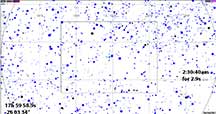
Thanks to Ted Swift for generating this.
The target is right next to a 9.0 magnitude star, which will make target hunting at low altitude in the Southeast easier.

This event has a 1-sigma range from San Luis Obispo to Pt Reyes. The asteroid is 13km in diameter, and an event will last up to 2.4s. Probably use 8x or even 16x to get good signal at this altitude. It will be in Sagittarius in a rich star field.
It is 2 degrees SSW of the Lagoon Nebula M8, At the time of the event, from Santa Cruz, it will be 12.3 degrees altitude and azimuth 137 degrees, at 2:30:37 am.
 |
Thanks to Ted Swift for generating this. |
The target is right next to a 9.0 magnitude star, which will make target hunting at low altitude in the Southeast easier. |
 |
For equatorially mounted telescopes and straight-through optics (no reflections, no diagonals), here's charts oriented north/south instead of alt/az as above
|
The eyepiece field, however, is still the same as for our own 8SE f/10 scopes with Q70 32mm eyepieces. Straight-through orientation so no flipping of horizontal. |
The wide field view, with circle centered on the target area. The Lagoon Nebula complex is at upper center. Target is at 12.4 degrees altitude and 137 degrees azimuth. |
Same FOV as the Watec 910hx for our 8SE. Only the rotation has changed from above |
Results:
I got a good response of interest for this, from my close-knit group at least. Karl got a good recording from home. And so did Kirk. I had a drive, and a late setup in high winds I had to protect from, and it ended up the telescope did not point to the target quite close enough, and I didn't recognize anything in the field or the immediate surroundings. If I'd gone another field width to the right, I'd have been able to ID the field, but the other problem was that there was a temptingly similar pair of bright-ish stars with a tempting target in the same orientation as the real target, even though the surrounding star fields did not match. I ended up running out of time and taping the wrong field. Karl and Kirk both had misses.
The biggest effort was from Chris Kitting, who drove all the way to Fremont Peak to get dark skies and high elevation to maximize odds, also closer to the predicted path. But trees and then clouds foiled his effort and he was not able to get data. So, 4 stations, 2 misses and 2 no-observations, was the result. Alas.
We'll try for another event by this asteroid in late September.